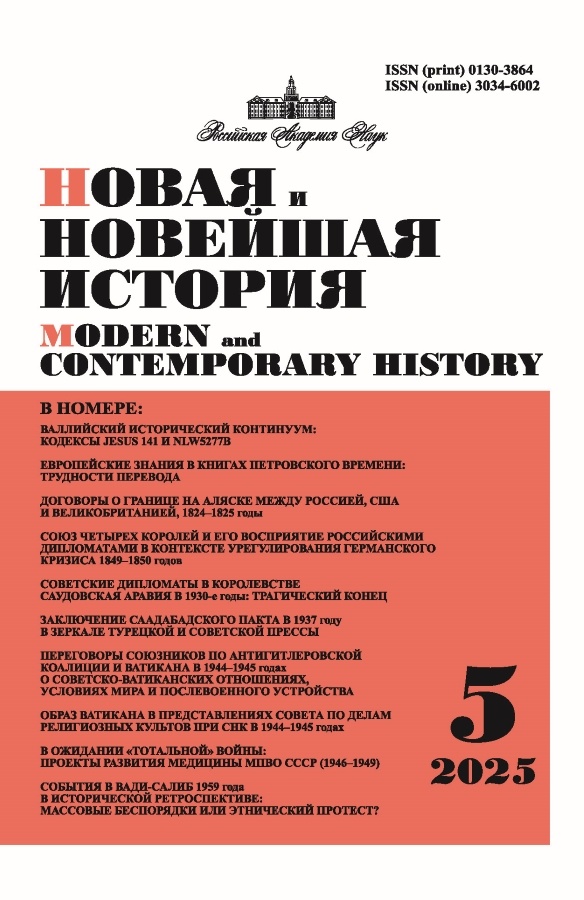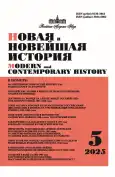Становление бессарабского дворянства в контексте политики областной автономии в 1810–1820 годах
- Авторы: ТАКИ В.В.1
-
Учреждения:
- Университет «Конкордия» в Эдмонтоне
- Выпуск: № 5 (2025)
- Страницы: 104-120
- Раздел: ИМПЕРСКИЕ ЭЛИТЫ И ПЕРСПЕКТИВА «ДЕЦЕНТРАЛИЗАЦИИ»
- URL: https://gynecology.orscience.ru/0130-3864/article/view/693045
- DOI: https://doi.org/10.31857/S0130386425050089
- ID: 693045
Цитировать
Полный текст
Аннотация
История региональных и местных элит Российской империи зачастую описывается сквозь призму дихотомии «автономия – централизация», в рамках которой столичные попытки униформизировать управление на окраинах наталкиваются на сопротивление местной знати, отстаивающей особую правовую традицию. Однако история Бессарабии в первые десятилетия после вхождения области в состав России в 1812 г. позволяет внести существенные нюансы в это расхожее представление. Политика широкой автономии, которой следовали российские власти до середины 1820-х годов, сопровождалась весьма существенными трениями между российскими губернаторами и представителями местной знати. Напротив, значительное сокращение бессарабской автономии во второй половине 1820-х годов способствовало снижению этих трений, ибо сопровождалось воспроизведением в Бессарабии общероссийских дворянских институтов. В результате Бессарабия представляла собой пример относительно успешной интеграции местной элиты посредством консолидации ее сословного статуса.
Ключевые слова
Об авторах
В. В. ТАКИ
Университет «Конкордия» в Эдмонтоне
Автор, ответственный за переписку.
Email: victor.taki@concordia.ab.ca
Эдмонтон, Альберта, Канада
Список литературы
- Вигель Ф.Ф. Замечания на нынешнее состояние Бессарабской области // Вигель Ф.Ф. Записки Филиппа Филипповича Вигеля. Т. 6. M., 1892. С. 1–34.
- Гроссман С.М. Местные законы Бессарабии. СПб., 1904.
- Гросул Я.М. Труды по истории Молдавии. Кишинев, 1982.
- Записки Бессарабского статистического комитета / ред. А.Н. Егунов. Т. 3. Кишинев, 1968. С. 109–110.
- Кассо Л.А. Петр Манега – забытый кодификатор бессарабского права. СПб., 1914.
- Крупенский А.Н. Краткий очерк о Бессарабском дворянстве. СПб., 1912.
- Кушко А., Таки В. Бессрабия в составе Российской империи. М., 2012.
- Накко А.Н. Очерк гражданского устройства Бессарабской области // Записки имперского Одесского общества истории и древностей. Т. 22. Одесса, 1900. С. 109–221.
- Свиньин П.П. Описание Бессарабской области // Записки Одесского общества истории и древностей. Т. 6. Одесса, 1867. С. 222–225.
- Стадницкий А. Гавриил Банулеско-Бодони, экзарх Молдовлахийский и митрополит Кишиневский. Кишинев, 1894.
- Уортман Р. Властители и судьи. Развитие правового сознания в императорской России. М., 2004.
- Cusco А. A Contested Borderland: Competing Romanian and Russian Visions of Bessarabia in the Late Nineteenth and the Early Twentieth Century. Budapest, 2017.
- Doyle M. Empires. Ithaca, New York, 1986.
- Ely С. This Meagre Nature: Landscape and National Identity in Imperial Russia. DeKalb, 2002.
- Febvre L. Frontière: the Word and the Concept // A New Kind of History: From the Writings of Lucien Febvre / ed. P. Burke. London, 1973. P. 208–218.
- Filitti I.C. Frământările politice on Principatele Române de la 1821 la 1828. Bucureşti, 1932.
- Freeze G.L. The Soslovie (Estate) Paradigm in Russian Social History // American Historical Review. 1986. Vol. 91. № 1. P. 11–36.
- Hitchins K. The Romanian National Movement in Transylvania, 1780–1849. Cambridge (MA), 1969.
- Ivanov L. Imaginea ruşilor şi a Rusiei în literatura Română. Iaşi, 2003.
- Jones R.E. Emancipation of Russian Nobility, 1762–1785. Princeton (NJ), 1973.
- Le Donne J. Ruling Russia: Politics and Administration in the Age of Absolutism, 1762–1796. Princeton (NJ), 1984.
- LeDonne J.P. Administrative Regionalization in the Russian Empire, 1802–1826 // Cahiers du monde russe. 2002. № 43. P. 5–34.
- Lincoln W.B. In the Vanguard of Reform: Russia’s Enlightened Bureaucrats, 1825–1861. DeKalb, 1981.
- Pintner W.M. The Social Characteristics of the Early Nineteenth-Century Russian Bureaucracy // Russian Review. 1970. Vol. 29. № 3. P. 429–443.
- Platon G., Platon A.F. Boierimea din Moldavia on secolul al XlX-lea. Bucureşti, 1995. P. 92–93.
- Regulamentul Organic al Moldovei / eds G. Bâdărău, D. Vitcu. Iaşi, 2004.
- Rhinelander A. Prince Michael Vorontsov: Vice-Roy to the Tsar. Montreal, 1990.
- Thaden E. Russia’s Western Borderlands, 1710–1870. Princeton (NJ), 1984. P. 44–45.
- Xenopol A.D. Primul proect de constituţie a Moldovei, cel din 1822. Bucureşti, 1898.
Дополнительные файлы








